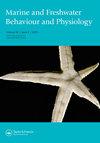A new animal-borne imaging system for studying the behavioral ecology of small sharks: laboratory and field evaluations
IF 1.1
4区 生物学
Q3 MARINE & FRESHWATER BIOLOGY
Marine and Freshwater Behaviour and Physiology
Pub Date : 2020-05-03
DOI:10.1080/10236244.2020.1782753
引用次数: 1
Abstract
ABSTRACT The use of animal-borne imaging and environmental data collection systems (AVEDs) can provide behavioral and ecological information of animals that many other technologies cannot usually offer. However, many previous AVEDs have been designed for larger sharks, and there is a need for a technology that permits the collection of behavioral and ecological data for small sharks. In this study, we developed and tested the Shark Harness, a novel AVED technology for small to medium size sharks, in both the laboratory and the field. In the laboratory, the swimming behavior of seven dusky smoothhound sharks (Mustelus canis; n = 7) ranging in size from 90.00–114.30 cm total length (TL) was assessed. When compared to unmanipulated individuals, sharks fitted with the Shark Harness exhibited no significant variations in both swimming duration (p = 0.63) and vertical positioning (0.99), whereas a minor, yet statistically significant, increase in tail beat frequency (p = 0.016) was observed. In the field, six dusky smoothhound sharks (90–110.28 cm TL) equipped with the Shark Harness were released in waters near Montauk, New York, USA. Field data suggest that the Shark Harness can be used to assess fine-scale movements, heterospecific interactions, and immediate post-release survivorship of dusky smoothhound sharks and other small sharks (≥80 cm TL) in a wild setting. However, future modifications are required prior to redeployment in a wild setting, including a more cryptic and hydrodynamic design, in order to obtain a more accurate representation of the respective animal’s natural behavior and interactions with con- and hetero-specifics.用于研究小鲨鱼行为生态学的一种新的动物传播成像系统:实验室和实地评估
动物传播成像和环境数据收集系统(AVEDs)的使用可以提供许多其他技术通常无法提供的动物行为和生态信息。然而,之前的许多aved都是为大型鲨鱼设计的,因此需要一种能够收集小型鲨鱼行为和生态数据的技术。在这项研究中,我们在实验室和现场开发并测试了Shark Harness,这是一种用于中小型鲨鱼的新型AVED技术。在实验室里,7只暗色冰沙猎犬鲨(Mustelus canis;n = 7),总长度(TL)为90.00-114.30 cm。与未被操纵的个体相比,戴上鲨鱼背带的鲨鱼在游泳时间(p = 0.63)和垂直位置(0.99)上没有显著变化,而尾巴拍打频率(p = 0.016)有轻微但有统计学意义的增加。在美国纽约蒙托克附近的水域,6条装备了鲨鱼背带的深色冰沙猎犬鲨鱼(90-110.28厘米)被放生。野外数据表明,鲨鱼脊具可用于评估野生环境中暗色滑狐鲨和其他小型鲨鱼(≥80 cm TL)的精细运动、异种相互作用和释放后的即时存活率。然而,在重新部署到野外环境之前,需要进行未来的修改,包括更神秘和流体动力学的设计,以便更准确地表示各自动物的自然行为以及与非特异性和非特异性的相互作用。
本文章由计算机程序翻译,如有差异,请以英文原文为准。
求助全文
约1分钟内获得全文
求助全文
来源期刊

Marine and Freshwater Behaviour and Physiology
生物-海洋与淡水生物学
CiteScore
2.10
自引率
0.00%
发文量
9
审稿时长
>12 weeks
期刊介绍:
Marine and Freshwater Behaviour and Physiology is devoted to the publication of papers covering field and laboratory research into all aspects of the behaviour and physiology of all marine and freshwater animals within the contexts of ecology, evolution and conservation.
As the living resources of the world’s oceans, rivers and lakes are attracting increasing attention as food sources for humans and for their role in global ecology, the journal will also publish the results of research in the areas of fisheries biology and technology where the behaviour and physiology described have clear links to the contexts mentioned above.
The journal will accept for publication Research Articles, Reviews, Rapid Communications and Technical Notes (see Instructions for authors for details). In addition, Editorials, Opinions and Book Reviews (invited and suggested) will also occasionally be published. Suggestions to the Editor-In-Chief for Special Issues are encouraged and will be considered on an ad hoc basis.
With the goal of supporting early career researchers, the journal particularly invites submissions from graduate students and post-doctoral researchers. In addition to recognising the time constraints and logistical limitations their research often faces, and their particular need for a prompt review process, accepted articles by such researchers will be given prominence within the journal (see Instructions for authors for details).
 求助内容:
求助内容: 应助结果提醒方式:
应助结果提醒方式:


